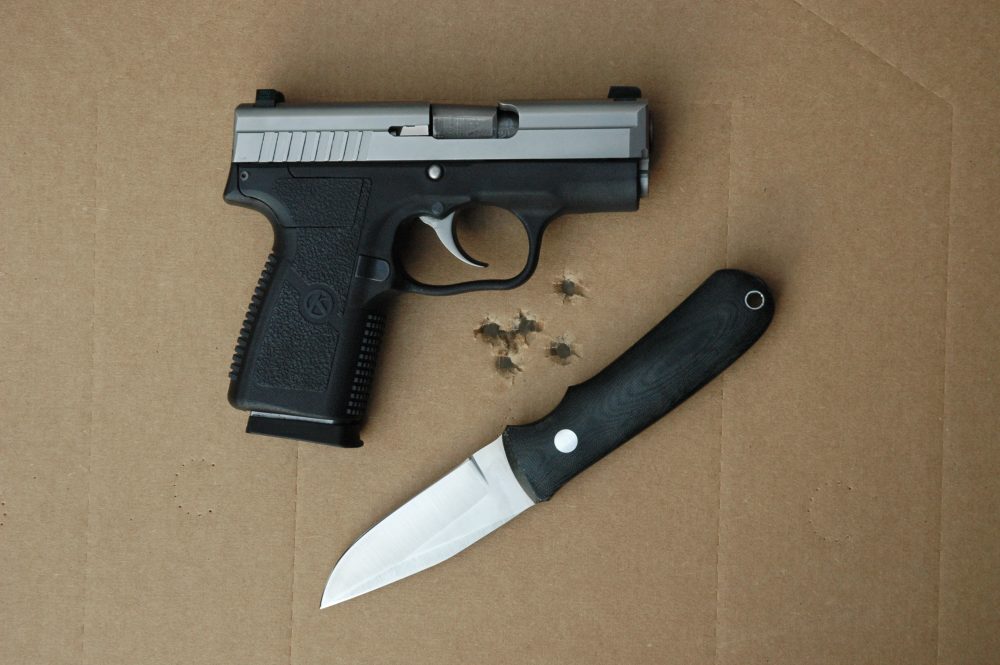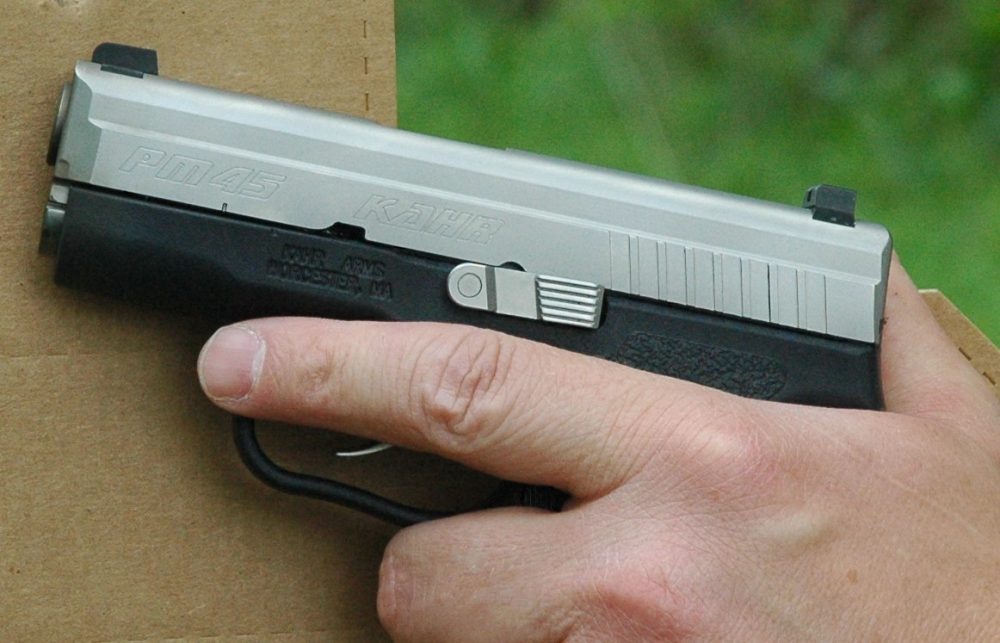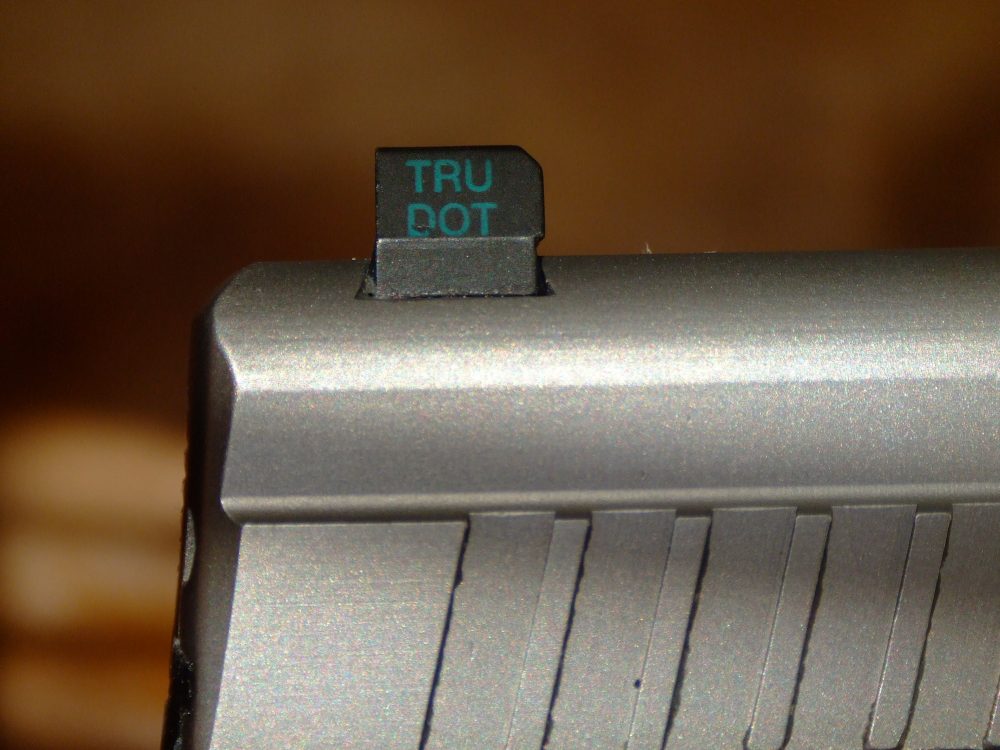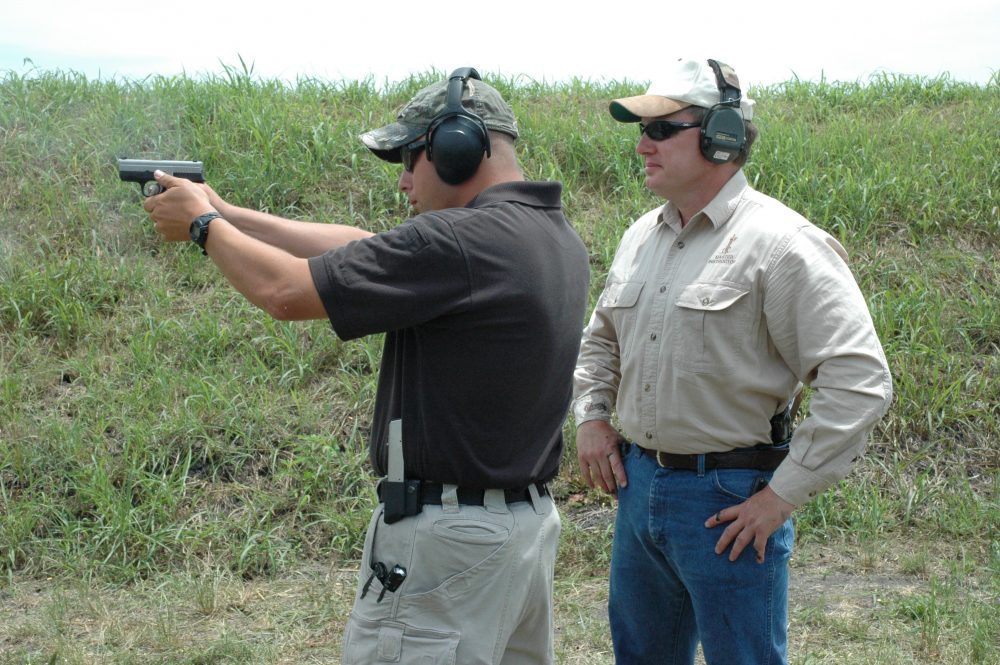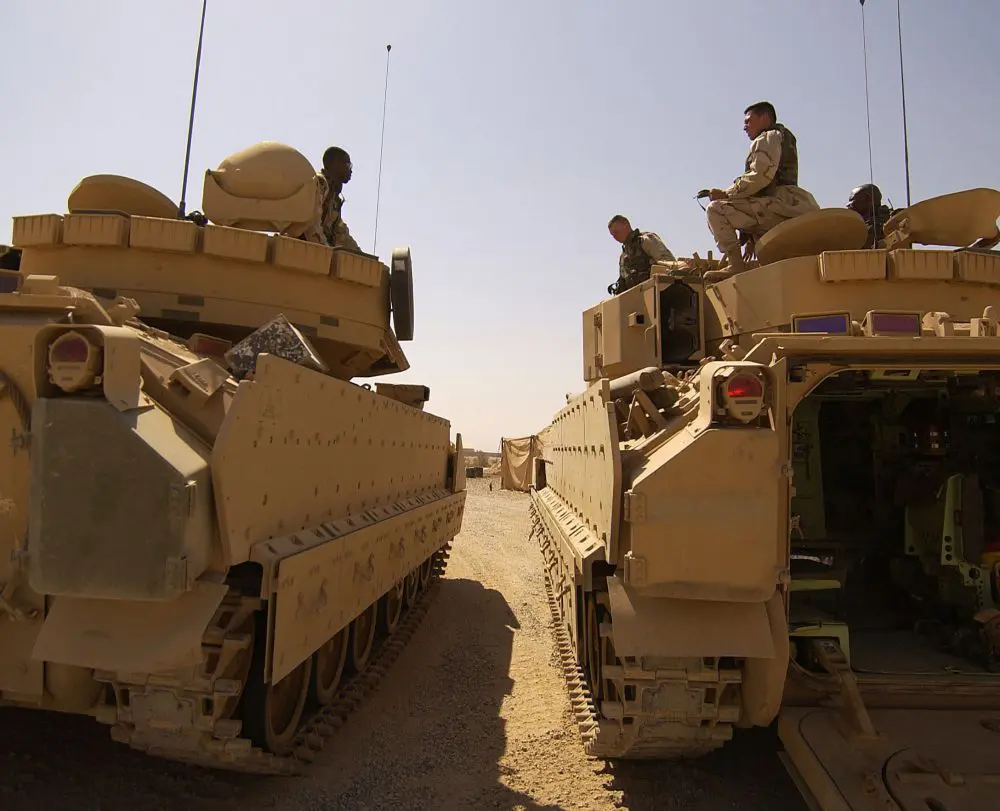PM45 is only a little larger than a Benjamin.
In a defensive pistol we want sights we can see, a useable trigger, utter reliability and a snag-free exterior, all housed in a handy package. A pistol possessing these traits, along with a round of proven fight-stopping capability and a dose of manly aesthetics, would be a fine pistol indeed. Which brings us to the subject at hand: the Kahr Arms PM45 chambered in .45 ACP.
Having owned and extensively shot the Kahr P40, I was looking forward to their producing a similar sized pistol in .45 ACP. Their release of the larger TP and KP models merely whetted my appetite. When they finally released the PM45 to the market, I was not disappointed.
Let’s begin by considering the physical and functional characteristics of the PM45 and then the practical role of a pocket .45 ACP.
Author’s daily carry—Kahr PM45 and Dozier Agent. Group is 1.25 inches fired from seven yards.
Table of Contents
PM45 SPECS
Environmental resistance was one of Kahr’s goals, and they achieved it through the use of polymer in the frame and stainless steel in the slide. The frame allows a secure grip, with molded textured side panels as well as checkering on the front and back straps. The slide is bead blasted and, along with the frame, nicely dehorned. The appearance is clean, businesslike and very nicely proportioned.
Colonel Cooper taught us that the pistol, due to power limitations, was not sufficient for the task to which we applied it, but that its virtue was convenience. As is true with many things, our own experience has proven him right once again. The rifle or shotgun we must usually retrieve, whereas the pistol is right there with us at all times.
The Kahr PM45 certainly meets the “convenience” requirement for a defensive pistol. The unloaded weight is approximately 19 ounces. Fully loaded with six rounds of 230-gr. hardball, the pistol weighs a click over a pound and a half and measures a little over 5.5 inches long and 4.5 inches tall. The slide is a svelte 1.01 inches and more like the sensuous 1911 than the brick-topped monsters so common today.
I believe the day of the .45 ACP ankle gun is here.
The fixed iron sights are of the typical Patridge style with a clean square notch in the rear and a post front sight. Both front and rear sights are drift adjustable, but no adjustment was necessary with the various brands of ammunition I put through the gun. The standard sights have a painted vertical bar inset beneath the rear sight notch and white dot inset in the front sight. Some may find these beneficial, but I tend to simply focus on the front sight and ignore the bars and dots.
I ordered my pistol with a set of the optional night sights because I find them very useful. Since the front of the rear night sight is flat, one-handed slide manipulations would be easily accomplished if the situation called for it.
Russell puts Kahr PM45 through its paces.
ACCURACY
The pistol is more than acceptably accurate. Groups of 1.25 inches with standard 230-gr. loads were shot at seven yards. I had several four-shot groups that were one ragged hole, but saved myself from fame by throwing the fifth shot out. Placing a round in the A zone of a standard IPSC target isn’t difficult at the range from which a good shooter would take that shot. In other words, if you can make the shot, this pistol can. A bullseye shooter might find something to criticize regarding the accuracy of this pistol—a warrior will not.
The majority of the ammunition used in testing was Black Hills .45 230-gr. FMJ, 230-gr. hollowpoint in both the standard and +P variety, and Federal American Eagle 230-gr. FMJ. Average velocity for the standard loads was 770 feet per second (fps) and 850 fps on the dot with +Ps. The +P is slightly harder recoiling than the standard load; however, the additional 80 fps of the +P was worth the difference to me.
Kahr informed me that a reasonable diet of +P loads would not harm the PM45 in the slightest. For reasons of expense, it might be prudent to use the standard-velocity loads for training and the higher-velocity +P loads for carry. Kahr also recommends that the recoil spring and guide rod assembly be changed out every 1,500 to 2,000 rounds.
Fixed iron sights are of typical Patridge style, with clean square notch in rear and post front sight. Front and rear sights are drift adjustable.
TRIGGER
The Kahr has a double-action-only trigger, which isn’t ideal. The ideal trigger on a defensive pistol is a single-action trigger pull set at a crisp three to four pounds. Notice that I said “ideal.” The single-action trigger I just described is simply easier to manipulate and that’s inarguable, but great work can be and has been done with different types of triggers, including Kahr’s DAO.
New, the PM45’s trigger averaged a very smooth 4.14 lbs with a rather long but distinct reset. It now averages 4.10 lbs and the reset is just as certain. For its purpose, this is a very usable trigger. If only our double-action revolvers came from the factory with such a fine trigger…
Mozambique drills, hammers and multiple-target arrays were easily addressed, thanks to the fine sights and good trigger on the PM45. My splits (the time between shots) on the hammers were very close to my times with a full-size gun.
The recoil of a 19-ounce .45 ACP is vigorous, as you would expect, but not uncomfortable. So far I have approximately 950 rounds through the gun. Of this number, 280 rounds were fired during a three-hour period. I felt no more discomfort or fatigue at the end of that session than I normally do after any intense training session.
Optional night sight design chosen by Russell makes one-handed slide manipulations very easy.
RELIABILITY
The PM45’s initial reliability was unimpressive, with numerous failures to feed and eject. However, the PM45 manual clearly states, “The Kahr pistol must run through an initial break-in period before achieving fully reliable feeding and functioning. The pistol should not be considered fully reliable until after it has fired 200 rounds.” My pistol certainly needed the break-in period.
Now that I have fired several hundred rounds through it, the pistol performs reliably as long as it is held with a very firm grip. This is not a five-inch 1911. What do I mean by that? The firing/extraction/ejection cycle of a 19-ounce .45 ACP with a three-inch barrel is considerably more dynamic than a full-size 1911 and therefore less forgiving of a not-so-firm grip on the gun.
Additionally, the slide would on occasion lock to the rear prematurely. After this occurred a few times, I realized that, being left-handed, my trigger finger was inadvertently bumping the slide-lock during the firing cycle, causing the slide to lock to the rear with a partially loaded magazine. Again, the solution was to utilize a firmer grip on the gun than I normally use, and the slide lock problem went away.
A few suggestions might be in order at this point. Keep the pistol clean and well lubricated, especially during the break-in period. Be patient and give it time to break in. My pistol seemed to prefer Black Hills, American Eagle, Blazer Brass, and Speer Gold Dot, but not Winchester white box. All were 230-gr. loads.
Kahr’s response to all of my inquiries was exemplary, as it has been in the past.
PM45 is dwarfed by author’s well-used 1911.
CARRY OPTIONS
There are several carry options for the little Kahr.
Galco does not list an ankle holster for this gun, however, I’ve had a Kahr P40 for years and recently purchased a Galco Ankle Glove for it. It came as a pleasant surprise when I found that the Ankle Glove fit the PM45 nicely. Obviously, Galco does not market the P40 Ankle Glove for the PM45, but in my experience it works just fine.
I also have an Alessi ankle holster for the P40 that works for the PM45.
An inside-the-waistband option is the C.T.A.C. by Comp-Tac. I’ve used this holster for several years with the 1911 and have found it to be extremely comfortable and secure. It also provides superb protection for the pistol.
Of course any fanny pack will also do.
Student in three-day Extreme Pistol Class fires Kahr PM45. Note minimal muzzle flip.
WHY AN ULTRA-COMPACT .45?
Some might conclude that there is no need for an ultra-compact .45 ACP since we have a plethora of smaller caliber compact weapons available. Call me contrary, but if I have several weapons to choose from that are of equal quality, reliability, and ease of use, I will choose the larger caliber weapon every time if ammunition is available. With the above criteria in mind, I struggle to understand why it would be preferable to punch a smaller hole rather than a larger one or choose a round less capable of defeating barriers and breaking bones.
Following this line of argument, some might ask why not carry a .44 Magnum, .475 Linebaugh, or .50 AE Desert Eagle? Our questioner has forgotten that part of our stated criteria is “ease of use.” Those weapons are much less concealable and more difficult to use when engaging multiple targets.
Granted, subjective judgment plays a part when men are able to select their own weaponry, and I am sure it does with me. We have good men who have done very sound work with the 9mm and 5.56 in Iraq and the Hindu Kush, but I personally believe this is a testament to the “caliber” of our men and not the effectiveness of the calibers issued to them.
We have to exercise caution in these areas lest we lose perspective. The cartridge and weapon are just two of the tools that a man fights with—his mindset and skills are more important. Through the processes of reason and investigation, you should identify the weapon system most effective for you, learn to use it well, then develop and maintain your skills through a rigorous training regimen. The result? You will be a very capable shooter indeed.
Some shooters may find that the advantages of the PM45 are not worth the increased recoil, break-in period and necessity of a firmer gun mount. I do.
It weighs an ounce less than the S&W Model 36, has superior sights, a much finer trigger and holds six rounds of .45 ACP versus five rounds of .38 Special. As fine as the little .38 is, the day of the .45 ACP ankle gun is here—at least for me.
SOURCES:
Kahr Arms
Dept. S.W.A.T.
P.O. Box 220
Blauvelt, NY 10913
(845) 652-8535
www.kahr.com
Alessi Holsters
2525 Walden Avenue
Cheektowaga, NY 14225
(716) 706-0321
www.alessigunholsters.com
Black Hills Ammunition
Dept. S.W.A.T.
P.O. Box 3090
Rapid City, SD 57709-3090
(605) 348-5150
www.black-hills.com
Comp-Tac Victory Gear
Dept. S.W.A.T.
P.O. Box 1809
Spring, TX 77383-1809
(281) 209-3040
www.comp-tac.com
Galco International
Dept. S.W.A.T.
2019 West Quail Avenue
Phoenix, AZ 85027
(800) 874-2526
www.usgalco.com


